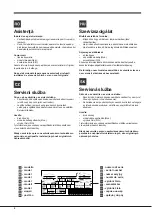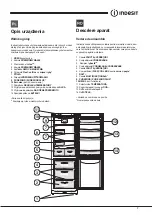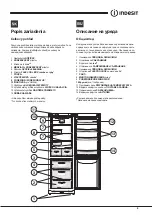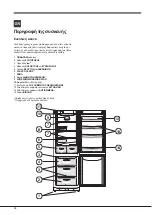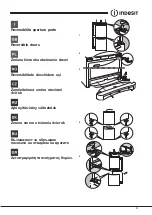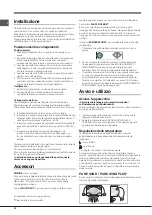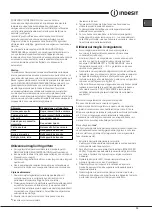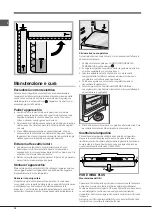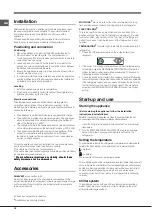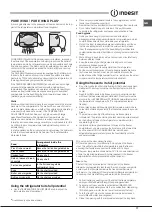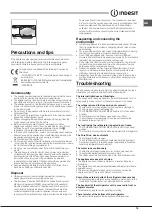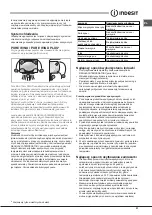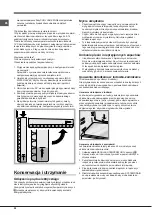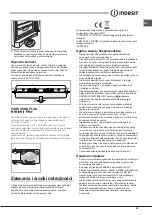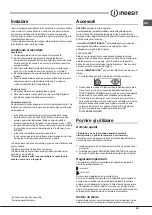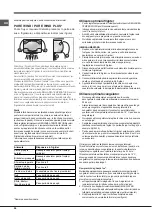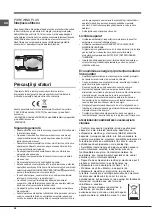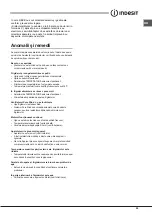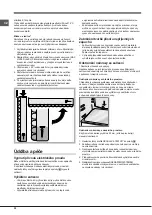
GB
17
PURE WIND / PURE WIND PLUS*
It is recognizable due to the presence of the mechanism on the top
part of the refrigerator compartment (
see diagram
).
A
B
B
B
A
PURE WIND / Pure Wind Plus maximises air circulation, improving
the efficiency of the evaporator and helping to achieve the optimal
temperature inside the refrigerator as quickly as possible each time
it has been opened. The blown air (A) is cooled when it comes into
contact with the cold wall, whereas the hotter air (B) is sucked up
(
see diagram
).
The Pure Wind Plus products are also equipped with a filter which,
thanks to the inclusion of silver ions, makes it possible to reduce
bacteria by 70% and to eliminate odours inside the refrigerator unit,
thereby guaranteeing improved food storage.
If the TEMPERATURE ADJUSTMENT knob has been set on high
values with large quantities of food and with a high ambient
temperature, the appliance can operate continuously, resulting in
excessive frost formation and excessive energy consumption:
compensate for this by shifting the knob towards lower values
(defrosting will occur automatically).
Static
Models without the Aircooler have the cooling section in the internal
back wall of the compartments. The wall will be covered in frost or
water droplets depending on whether the compressor is operating
or paused: both cases are normal. If the TEMPERATURE
ADJUSTMENT knob has been set on high values with large
quantities of food and with a high ambient temperature, the
appliance can operate continuously, resulting in excessive frost
formation and excessive energy consumption: compensate for this
by shifting the knob towards lower values (defrosting will occur
automatically).
In static appliances, the air circulates in a natural way: the colder air
tends to move downwards as it is heavier. The food should be
stored as follows:
Food
Arrangement inside the
refrigerator
Fresh fish and meat
Above the fruit and vegetable bins
Fresh cheese
Above the fruit and vegetable bins
Cooked food
On any shelf
Salami, loaves of bread,
chocolate
On any shelf
Fruit and vegetables
In the fruit and vegetable
compartment bins
Eggs
On the shelf provided
Butter and margarine
On the shelf provided
Bottles, drinks, milk
On the shelves provided
Using the refrigerator to its full potential
• Use the TEMPERATURE ADJUSTMENT knob to adjust the
temperature (
see Description
).
• Place only cold or lukewarm foods in the compartment, not hot
foods (
see Precautions and tips
).
• Remember that cooked foods do not last longer than raw foods.
• Do not store liquids in open containers. They will increase
humidity in the refrigerator and cause condensation to form.
Food hygiene
1. Once you have bought your food, remove all external
packaging made of paper/cardboard or other wrappers, which
could introduce bacteria or dirt inside your refrigerator.
2. Protect the food, (especially easily perishable items and those
that have a strong smell), in order to avoid contact between
them, thereby removing both the possibility of germ/bacteria
contamination as well as the diffusion of strong odours inside the
fridge.
3. Store all food in such a way as to ensure air can circulate freely
between different items.
4. Keep the inside of your fridge clean, taking care not to use
oxidiser or abrasive products.
5. Remove all food past its expiry date from the refrigerator.
6. For the correct preservation of food, all easily perishable items
(soft cheeses, raw fish, meat, etc.) should be stored in the
coldest zone of the fridge compartment, i.e. just above the salad
crisper where the temperature indicator is situated.
Using the freezer to its full potential
• Do not re-freeze food that is defrosting or that has already been
defrosted. These foods must be cooked and eaten (within 24
hours).
• Fresh food that needs to be frozen must not come into contact
with food that has already been defrosted. Fresh food must be
stored in the top FREEZER and STORAGE compartment where
the temperature drops below -18°C and guarantees rapid
freezing.
• Do not place glass bottles which contain liquids, and which are
corked or hermetically sealed in the freezer because they could
break.
• The maximum quantity of food that may be frozen daily is
indicated on the plate containing the technical properties located
on the bottom left side of the refrigerator compartment (for
example: Kg/24h: 4)
• In order to obtain a greater amount of space in the freezer
compartment, you may remove the bins (except the lowest bin
and the special COOL CARE ZONE bin, which has an
adjustable temperature) and place the food directly onto the
evaporator plates.
!
Do not open the door during freezing.
!
If there is a power cut or malfunction, do not open the freezer
door. This will help maintain the temperature inside the freezer,
ensuring that foods are conserved for at least 9 -14 hours.
!
If the room temperature drops below 14°C for an extended period
of time, the ideal temperature will not be reached in the freezer
compartment and food preservation will be reduced.
Ice
3
ice tray
The fact that they are situated on the top part of the freezer
drawers ensures greater cleanliness: the ice no longer comes into
contact with the food placed inside the freezer compartment;
furthermore, the dripping of the water during filling is avoided (a lid
to cover up the hole after filling with water is also provided).
1. Pull out the tray by pushing it up. Check that the tray is ompletely
empty and fill it with water through the opening provided.
2. Take care not to exceed the level indicated (MAX WATER
LEVEL). Excess water prevents the ice cubes from dispensing
(if this happens, wait for the ice to melt and empty the tray).
3. Turn the tray 90°: due to the connected compartments each
mould fills with water (
see diagram
).
4. Close the opening with the lid provided and put the tray back,
*
Available only on certain models.
Summary of Contents for BAAAN13 Series
Page 4: ...4 modello model ìïíôÝëï numero di serie serial number áñéèìüò óåéñÜò ...
Page 20: ...20 PL ...
Page 22: ...22 PL WATER LEVEL MAX WATER LEVEL MAX WATER LEVEL MAX ...
Page 24: ...24 PL ...
Page 25: ...RO 25 ...
Page 27: ...RO 27 WATER LEVEL MAX WATER LEVEL MAX WATER LEVEL MAX 1 1 2 ...
Page 28: ...28 RO ...
Page 29: ...RO 29 ...
Page 30: ...30 CZ ...
Page 32: ...32 CZ WATER LEVEL MAX WATER LEVEL MAX WATER LEVEL MAX ...
Page 33: ...CZ 33 1 1 2 ...
Page 34: ...34 CZ ...
Page 35: ...HU 35 ...
Page 38: ...38 HU ...
Page 39: ...SK 39 ...
Page 41: ...SK 41 WATER LEVEL MAX WATER LEVEL MAX WATER LEVEL MAX ...
Page 42: ...42 SK 1 1 2 ...
Page 43: ...SK 43 ...
Page 44: ...44 BU ...
Page 46: ...46 BU WATER LEVEL MAX WATER LEVEL MAX WATER LEVEL MAX ...
Page 47: ...BU 47 1 1 2 ...
Page 48: ...48 BU ...
Page 54: ...54 GR ...
Page 55: ...GR 55 ...
Page 56: ...56 GR 195093696 00 05 2011 ...


